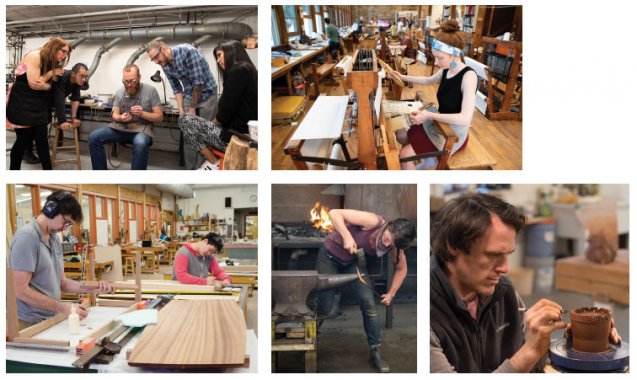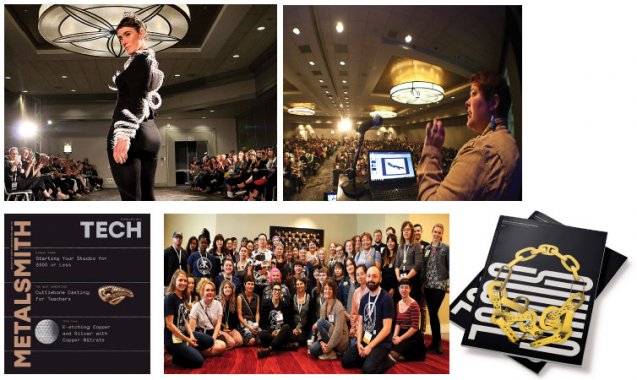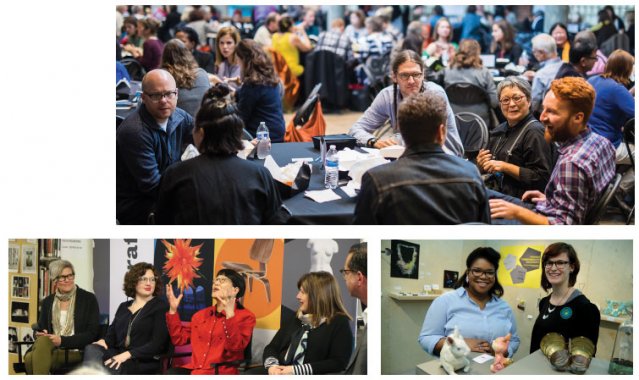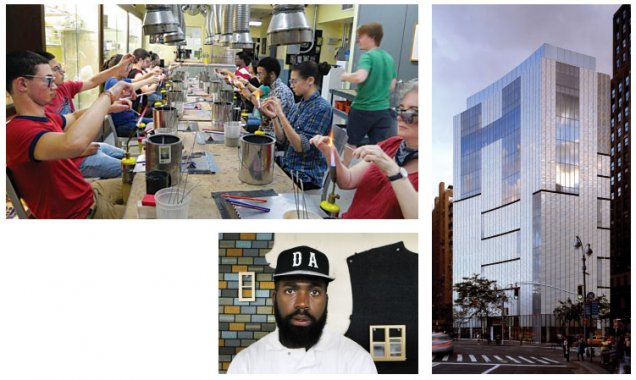View from the Top
View from the Top
In the past year, the winds of change have blown through many organizations and institutions that focus on craft. For one thing, there’s been a wave of retirements – a real changing of the guard:
- Fuller Craft Museum executive director Jonathan Fairbanks retired; he’s been succeeded by Denise Lebica, who was deputy director at the museum.
- Jean McLaughlin retired from the top job at the Penland School of Crafts after almost 20 years. She was succeeded by Mia Hall of the University of Arkansas at Little Rock.
- James Baker retired from Pilchuck Glass School, succeeded by Christopher Taylor of the Clay Studio. Jennifer Martin was promoted from within to take over at the Philadelphia ceramic center.
- After 31 years at the helm of the Center for Art in Wood, Albert LeCoff retired, succeeded by Jennifer-Navva Milliken of the Bellevue Arts Museum.
And there were other high-profile transitions:
- Chris Amundsen, American Craft Council executive director since 2010, left his post, to be succeeded by Sarah Schultz, a contemporary art curator and education director.
- Suzanne Ramljak departed as editor of Metalsmith magazine, published by the Society of North American Goldsmiths. Emily Zilber from the Museum of Fine Arts, Boston, is the new editor.
- The Museum of Arts and Design, leaderless for more than a year, hired Christopher Scoates from the Cranbrook Academy of Art and Art Museum for the executive director job.
- Fabio Fernández left the executive director’s job at the Society of Arts & Crafts in Boston to return to the studio.
- Todd Herman was named president and CEO of the Mint Museum in Charlotte, North Carolina, replacing Kathleen V. Jameson.
There are so many new leaders in new places that perhaps this 2018 cohort could start its own book club – or friendly support group. What’s on their minds as they tackle their new roles?
We worked with another leading voice, Namita Gupta Wiggers, to find out. Wiggers, a longtime curator and the co-founder and director of the Critical Craft Forum, now finds herself with an additional title: founding director of the new master’s program in critical and historical craft studies at Warren Wilson College. Our conversation with four leaders in new roles follows.
What parts of your former position will you bring to your new one?
Mia Hall: What I’m bringing to Penland is the knowledge of a teacher and a maker. I have an MFA in furniture design from San Diego State University, and I taught for 10 years. I think that is hugely beneficial when it comes to making decisions about programming and about the organization as a whole. For me, administration is the new part. I served as a department chair for a little over a year, so not a long time. But it’s something I’m very interested in.
Christopher Scoates: In many ways, my former role as director at Cranbrook and my new role as director of MAD are parallel. I graduated from Cranbrook in 1986 with a degree in photography; Gary Griffin was teaching metals, Jun Kaneko was teaching ceramics, and at that time, Gerhardt Knodel was teaching fiber and then went on to lead Cranbrook Academy. If you think back to the history and the legacy of MAD and Cranbrook, you’ve got people like Iris Eichenberg, who started teaching in the metals department, in the MAD collection. Also, Jun Kaneko, Graham Marks – all of those artists in residence at the academy who also exhibited at MAD and are in the collection. There are a lot of parallels.
Emily Zilber: I’m coming from eight years as a curator in an encyclopedic museum, where my purview was not just to think about craft, but craft as it fits within the broader context of contemporary art and within the broader scope of the history of art. That’s something that you can do on the page, as well as in the exhibition space, and so I’ll certainly be bringing that perspective with me.
Sarah Schultz: I’m coming to this position from the contemporary art world, with a long career as a museum educator working in the realm of public engagement and socially engaged art practice. I’m very committed to thinking about craft much as I do art, as a kind of dynamic social activity and, really, as a kind of process, a way of thinking, a way of approaching the world, a way of approaching a life. I’m also trained as an art historian, so I’m able to reinforce the importance of the stewardship role of the ACC. I have an appreciation for how traditional canons have excluded people from conversation, have excluded people from history. Lastly, I’m very committed to providing opportunities for artists to make work, receive critical attention for their work, and sustain a creative life.
What are the biggest challenges you anticipate in your new positions?
Zilber: I’m focused on audiences who are not only invested and knowledgeable about craft, but also those who don’t think they know anything about it. How do we bring the artists and makers we love to an audience who doesn’t yet know that this is for them?
Hall: For me, everything is hinging on that one big problem – that is, finding that new audience. At first, I had “fundraising” there; but if we can’t find a new audience, we can’t fundraise. We do a lot of recruiting in academia. And that’s great for finding the next generation of makers, but it does not necessarily help us find collectors and the supporters and the people who give larger gifts.
Expanding the audience is difficult right now, and I think it’s going to be difficult for a while because of where the educational system has gone – we’re cutting out a lot of art at a very young age. It’s a pretty tall order, but we need to reconnect with education and get making back into the curriculum
Schultz: I see my challenges as opportunities. I think the way that people think of culture and engage with culture is changing. The kinds of distinctions and divisions that we may have had between craft, art, design, popular culture, what constitutes culture, have become very blurry. This also speaks to a younger culture. Perhaps there’s not making being done in the schools, but the way that young people want to engage with culture is different. Young people are more interested in experiences than they are in things, to some extent. There are economic shifts, there are political shifts. The whole landscape is shifting, and I think we need to understand how we fit into that, or how we may want to change to live in that world.
Scoates: Honestly, I think of challenges as opportunities, too. And there’s an opportunity for MAD to become a platform for thinking in new ways about arts and design. Also, we’ll be imagining ways to build the audience, bring in new people and different kinds of projects – to think about design differently, to think about craft differently.
Zilber: I’m thinking about what it means to be a medium-specific publication in an increasingly interdisciplinary or post-disciplinary landscape: What is and isn’t our turf? Metalsmith covers metals and jewelry – what does that mean? Does it mean furniture? Does it mean design? Does it mean contemporary art? Does it mean factory craft? How broad can we take that, as long as we’re dealing with materials and the themes around adornment and the body? In some ways, we take it as broad as the people who are making take it, and our job as organizations is not only to set paths and to provide opportunities, but also to look at what’s happening and try not to be too quick to make big shifts to reflect the world around us.
And also, today, there’s suspicion around the expert – the curator or the editor or even the administrator. We live in a much more horizontal kind of landscape now. What does it mean to be something that aggregates culture or provides opportunities in a world where the notion of expertise is changing?
Schultz: And here’s one question we need to help answer in this new world: What does it look like to have a career in craft?
Zilber: Yes. We’ve developed a whole new publication that looks at the notion of how-to, but really broadly. Metalsmith Tech is not just how to make, but it’s also thinking about how to make a career. What does a career look like? What resources do you need?
Navigating these challenges seems important to being relevant to new audiences. What other ideas do you have about developing audiences?
Scoates: Every institution, whether it’s an educational institution like Cranbrook or a museum like MAD, needs to work to stay relevant. If you look at MAD’s most recent projects with Derrick Adams and Tanya Aguiñiga, there are numerous examples of ways we’ve aimed to expand the audience to address new groups. And there’s the Van Lier fellowship, which is committed to supporting talented young people from historically underrepresented populations. There’s the outreach program, which serves at-risk middle and high school students.
Art education is crucial. When I was 8, 9, 10 years old, living in England and going on field trips to the Tate and other institutions to see exhibitions I knew nothing about, I got incredibly interested. I went to see a Francis Bacon exhibition at the Tate when I was probably 10 or 11. I didn’t know much about him as a painter, but I bought a cassette of Bacon being interviewed and I listened to that thing for hours. And I was fascinated by the language, which I slowly began to understand. How do you get children to enter the conversation today?
Hall: I thought about new audiences when I went to the Burning Man exhibition at the Renwick. I was really, really struck by the objects there. And I realized that these are like-minded people we need to reach out to; the craft field and the Burning Man community have been fairly separate. It was just such a great revelation, because I’m about to turn 50, and I’ve never really had a desire to go to Burning Man; it was just never really appealing to go out in the desert and stand in line for the porta-potties. But I realized that there’s definitely something there.
I’ve also engaged with maker fairs. Someone told me the maker fairs are so popular because all the people our age who used to go to Burning Man now have families, so now they go to maker fairs. I see very interesting things happening at maker fairs; it’s a little broader than what we are because of all the technology, but I see that as a source for a new audience.
Those are just the two groups that struck me right away. I really like what you said, Emily, about connecting with the people who don’t know that they are interested in craft – that they are makers or they are collectors – because they haven’t fully experienced it yet.
Schultz: To follow up on your comment about Burning Man and maker fairs, it seems to me that making, actually, is having an ascendancy, a renaissance. We’re living in a moment where the artisanal, the authentic handmade, has a kind of new life. Craft is on an ascendancy. If you take everything from the DIY to the idea of contemporary art, craft, and you have studio craft somewhere on that spectrum, the spectrum is so broad. I’m really interested at looking at the sensibilities and values and even the practices that may thread through that spectrum, as a way to think about how we might get more people under that big tent.
Zilber: At SNAG, we have some pretty important anniversaries coming up. Next year, it’s the 50th anniversary of the organization. In 2020, it’s the 40th anniversary of the magazine. Those provide natural moments to say, “Who were we speaking to, and who can we be speaking to?”
For example, we don’t talk to the design community enough. That’s another one of these value judgments: If it’s design, if it’s moving into that bigger, broader, mass-produced world, then, of course, it’s not valuable for us in the landscape of craft. Whereas I think about my last visit to the Autodesk’s Build Space in Boston, and there were folks connected to the ceramics program at Harvard, there were glassblowers there, and they’re really thinking about how their knowledge of materials can be adapted.
Scoates: The design fields have changed the world around us. There’s sound design, there’s film design, there’s interactive design, there’s data design – there are lots of possibilities for new audiences. Think about fiber and smart fiber – there are new ways of thinking about clothing and technology. You just have to expand the definitions and be willing to talk about how they fit into the discipline of craft and material.
Hall: Well, I agree with the idea of broadening the field, but also with redefining and broadening the term “craft.” I look at our programming at Penland, for example. Last summer, we had a really interesting class in how to make bicycle frames. For two weeks, the students were measuring their own bodies and doing all the mathematical calculations, and then they designed and made a bicycle frame for themselves. This year, we have a class on how to sew custom jeans for yourself. Over the years, I’ve definitely broadened my own view of “What is craft?” and moved away from the five-mediums definition.
I keep using the term “skilled making,” because at Penland, we offer classes in drawing and painting and photography and papermaking and bookmaking – a lot of classes that are not necessarily identified as craft disciplines. But anything can be part of it when you practice this slow attention to detail and dig deeply into how things are made and why. Every single class has that same attention to making. That doesn’t mean the classes don’t deal with concept or narrative, but it will never just be a discussion about the concept of the work. The skilled making aspect is always there.
Schultz: We need to listen to the people we want to engage and really understand what is important to them and what they need and what they want. We can never really make assumptions about that. The brilliance and joy of working with artists is they never stay in their lane.
The same is true of younger generations. People are making things; they’re creating their own culture. They engage in culture, and they will do it, with or without you. They’re not waiting for you. People will make their own worlds. They will create their own communities. The question for the ACC is “How can we be a place where all these different people who have different kinds of affiliations can all find a place?”
Hall: I really like what you just said, this idea of listening to artists and having an open approach to what craft is. Letting artists be artists. We can leave it to the theorists and the historians to sort it out later.
I’m thinking about the homogeneity of the field. There are few people of color in any leadership role at craft-centric institutions. How will you do your part to address this?
Scoates: Well, you’re talking to a middle-aged white guy who just got hired as a museum director. So it’s an issue, I agree with that. And I think it goes back to getting people into the field, getting people, at an early age, interested in art and culture. It’s a difficult and complex question that goes back to exhibitions that include issues around diversity, to start with, including artists who tell different stories, who show different kinds of work. And it’s also about education, honestly.
I’m not proud of this fact, by any means, but at Cranbrook we only recently hired our first African American artist in residence, Danielle Dean. She’s great. We also did a wonderful project with Nick Cave a couple years back; Nick is an alum. It was a large exhibition, and he said, “I don’t want to do it just at Cranbrook. I need to address the city of Detroit.” We said, “Absolutely.” We’re 22 miles north of Detroit, a community that is incredibly diverse and interested. We did dance performances, film screenings, all over the city, and it was probably the most successful project we’d ever done.
It was important to get beyond the walls of the institution – to go out into the community and address different audiences, different constituents who wouldn’t go to Cranbrook on a regular basis. It was absolutely fantastic.
Schultz: All of the strategies you mentioned are important to achieving institutional change. In my experience, organizations that are truly inclusive work across both the institution and field to address the different types of barriers to participation, power, and leadership. Listening, sharing power, and an openness to changing course are critical. And you can’t assign change to only one part of the institution. You need to address it through your board and leadership, the programs you present, inviting new voices into the conversation, an awareness of the histories that shaped you, and being intentional about prioritizing resources.
Hall: All of the craft schools are talking about diversity and the lack of diversity, and we’re all trying to solve that problem. It’s a systemic problem. It’s “How do we connect with a more diverse group of people much earlier on than we are right now? How do we pull a more diverse group of people into the craft field?” It has to be done much, much earlier than trying to find people in their 40s and 50s that give us more diversity. So I’m back to education.
Zilber: This is a question that’s very much on my mind as I think about future advisory committee members and contributors for Metalsmith. A more diverse set of participants in talking about the magazine’s content will hopefully help generate coverage of a greater spectrum of makers from a wider variety of backgrounds. Publications like Metalsmith have the capacity to present more models for who works in the field.
Diversity touches on questions around economics and class. We need to do more to make it sustainable for people from all economic backgrounds to get the training and time it takes to have a life in this field. It’s one thing that appeals to me about the new magazine, Metalsmith Tech. In operating with less opacity around how one makes a living in the field, we enable potential students, recent grads, and emerging professionals to have a greater sense of what the challenges, compromises, and questions to ask might be – without feeling like they’ve committed some sin of not being “serious” artists by talking openly about resources. It’s a privilege not to talk about how we fund our lives as artists or curators or writers.
Let’s talk about fundraising. What’s the climate like, and what are some of the ways you’ll be addressing the challenges?
Scoates: I think it’s tough. But partnering can help. When I was at California State University, Long Beach, we partnered with the Art Directors Guild. The [university] museum wanted to collaborate on thinking about the future of architecture, design, art, TV, animation, and gaming. Working with them opened up new funding possibilities that we did not have access to before. We pulled off what was perhaps the largest conference in the university’s history in 2008. We had an incredible group from around the world come to talk about these various issues. And we got access to sponsors, underwriters, and partners that we would never have [found] working alone as a university art museum.
Hall: Penland tried something a little bit different last year. We have a development team, of course, and they raise a lot of money through our big benefit auction and annual appeal and all of that.
But last year, they decided to do a giving day and set a goal – not dollars raised but rather number of new donors. And we found that a lot of our younger donors don’t view themselves as donors, because they cannot give thousands of dollars. So they don’t engage. But what we saw with that giving day was we had a lot of new donors, and it started at $5. And people were telling us that “I can give $5. I can give $10.” In the end, we ended up raising quite a bit of money.
Schultz: I think you make an important point. Young people want to give their money. People want to give their time to something they believe in, and, I think, establishing what your relevance is – having a compelling story about who you are, what you do, why you matter, and how other people belong within that, how they see themselves as belonging – is really important for anyone to give, anyone to support you, regardless of where they’re at. It’s getting people in early and valuing their contribution, whatever it is, because they’re participating by doing that. Participation, for me, is the key.
Zilber: I come at this from a slightly different perspective. We’ve been thinking about this as it relates to advertisers and people who help allow us to run the magazine on a day-to-day basis. But in terms of that increase of buy-in, it doesn’t matter who you’re talking to, whether it’s a consumer or a reader or somebody who’s a funder. Give people a reason to be part of what you’re doing, and they can see themselves having a role in it.





